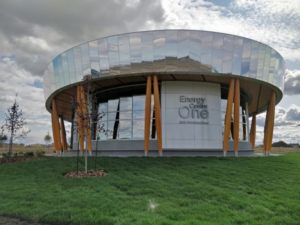The Canadian Urban Institute’s “Building Canada’s Largest Carbon-Neutral Community: Inside City of Edmonton’s Blatchford Redevelopment” webinar on November 12, 2019 confirmed that the large-scale project is on track and provided a compelling overview of the financial and environmental reasons to embrace carbon-neutral living.
Webinar presenters included: Geneva Starr, project manager with LSNetwork, Canadian Urban Institute; Tom Lumsden, development manager with Blatchford, City of Edmonton; Larissa McCleod, senior land development engineer, Blatchford Redevelopment Office, City of Edmonton; Christian Felske, director of renewable energy systems, integrated infrastructure systems, City of Edmonton.


Energy Centre One provides storage for the District Energy Sharing System’s mechanical equipment and is also designed to be a civic building that is a showpiece for sustainability. Photo: Blatchford Homes.
The presenters provided updates on the redevelopment of the former City Centre Airport site, which includes 217 hectares of land. The strategies are designed to result in an optimally sustainable community that will be powered by 100 per cent renewable energy and will accommodate approximately 30,000 residents and multi-use facilities.
“The emphasis is on environmental, social and fiscal responsibility,” said Lumsden. “The LRT stations are a green approach for commuting to work. This is a people first community we want everyone to feel comfortable on their feet and on their bikes.”
The Canadian Urban Institute’s LSNetwork supports the adoption of smart and efficient technologies to help reduce greenhouse gas (GHG) emissions and improve the overall qualify of life in Canada. Today’s webinar provided the details on this large-scale carbon-neutral development and the solutions they are using to get there, including:
- One of Canada’s largest District Energy Sharing Systems (DESS), projected to reduce GHG emissions by 74 per cent;
- High energy performance buildings;
- Waste diversion strategies for over 90 per cent of materials to be diverted from landfills;
- Eco-friendly travel that prioritizes active and public transportation.
By all accounts the Blatchford community and homes will be designed for green living from the ground up. Residences will feature solar photovoltaics, optimal energy efficiency and zero carbon for operations without a furnace. Blatchford employs three linked strategies – conservation, efficiency and use of renewables – to minimize environmental impacts and ensure energy resiliency.
- Conservation: The energy conservation strategy mandates the construction of high-performance buildings to reduce the amount of energy needed for heating and cooling.
- Efficiency: After reducing the amount of energy needed, the energy that is still required for heating, cooling and providing hot water to buildings will be delivered through an energy efficient DESS. The DESS uses a geoexchange field to harness the shallow geothermal energy below the earth’s surface.
- Renewables: Renewable energy sources such as geoexchange and sewer heat exchange will tie into the DESS. For the first stage of residential development, a geoexchange field consisting of 570 boreholes is located under the first stormwater pond. Future solar PV installations will also be used to offset the electricity needed to run the DESS equipment.
“There will be a critical reduction in energy consumption, about 23,000 killowatts annually, which is a two-third decrease compared to typical townhomes,” said Feslske. “The annual reduction of 29,318 metric tonnes of carbon dioxide is the equivalent of taking more than 6,000 cars off the road annually.”
Other environmental strategies will add to the sustainable success of the community. The stormwater management strategy will provide combination of low impact development design features such as bioswales, rain gardens and stormwater ponds to slow down and capture water runoff, and to improve the water quality before it enters the drainage system. Many of these areas will also provide micro-habitats where plants, trees and birds can thrive, adding more green space and biodiversity.
The green building strategies also include a comprehensive recycling program during building construction to reduce the amount of materials going to the landfill and features such as increased insulation, smart room thermostats, energy- and water-efficient appliances, low-flow fixtures, high-quality windows, and a tighter building envelope to reduce heat loss.
For further information on the Blatchford development, click here.
For further information on the Canadian Urban Institute and the LSNetwork, click here.









